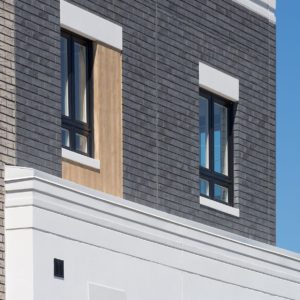Through the headwinds of adversity, Black architects have shaped America’s skylines. In honor of Black History Month, the Architrends blog takes a look at four Black architects – two from the past and two visionaries of today – who are among the many worth celebrating.

Beverly Loraine Greene
In 1942, Beverly Loraine Greene was believed to be the first female architect licensed in the United States. Following graduation from the University of Illinois in 1936, she became the first African-American to earn a degree from the university and went on to earn a master’s degree in city planning and housing. Following stints with the Chicago Housing Authority and a downtown firm, she moved to New York City after finding it difficult to hurdle race barriers within the city.
Per Wikipedia, “A 1945 newspaper report about the Metropolitan Life Insurance Company’s development project at Stuyvesant Town led Greene to move to New York City. She submitted her application to help design it, in spite of the developer’s racially segregated housing plans; and much to her surprise, she was hired. After only a few days, she quit the project to accept a scholarship for the master’s degree program at Columbia University.”
Her career saw her work on buildings such as the theater at the University of Arkansas, Arts Complex at Sarah Lawrence College and designs for the UNESCO United Nations Headquarters in Paris.
Paul R. Williams
Responsible for over 3,000 structures, Los Angeles-based Paul R. Williams passed away at the age of 85 in 1980. In his 20s, he served on the city’s planning commission. He was the first Black architect to become a member of the American Institute of Architects and to win the association’s Gold Medal (though posthumously). His designs include the Los Angeles County Courthouse, the Golden State Mutual Life Insurance Building, Hillside Memorial Park, Westwood Medical Center, and First AME Church, in addition to homes for the wealthy as well as affordable housing projects. Per Los Angeles Conservancy,
“Highly astute, Williams masterfully navigated the business and social circles of the day. He even learned to draw upside down in order to sketch for clients from across the table—for the benefit of any white clients who might have been uneasy sitting next to an African American.”
David Kirk
David Kirk, president and CEO at DNK Architects, Inc has over 30 of years of experience on public and commercial projects. His clients have included the Cincinnati and Dayton public school systems, Cincinnati Children’s Hospital Medical Center, and the Duke Energy Convention Center in downtown Cincinnati. Per Cincinatti.com,
“Kirk also worked with the National Organization of Minority Architects to develop programs to introduce architecture as an occupation to African American youth around the country. His past and current professional affiliations include the African American CEO Roundtable, Cincinnati USA Regional Chamber Roundtable and the National Organization of Minority Architects. He’s also a member of the Hamilton County Board of Building Standards.”
Roberta Washington
Washington’s firm, Roberta Washington Architects, has designed and acted as project director for several new and renovated housing projects, schools and health facilities. Per Architizer,
“….Roberta Washington Architects is one of the few African-American, women-owned architectural firms in the country. Washington has had a multifaceted career, working internationally as a designer in Maputo, Mozambique, and serving as past president of the National Organization of Minority Architects, and is currently a Center for Architecture Foundation board member. She was made a Fellow of the American Institute of Architects in 2006 in recognition for her wide-ranging, impactful career.”
These four selections are but a small sample of many great Black architectural visionaries that have made their mark on the industry and the country. Do you have any inspirational architects in mind that you would like to add to the discussion? Follow us on Twitter, Facebook, LinkedIn or Instagram and join the conversation today.


